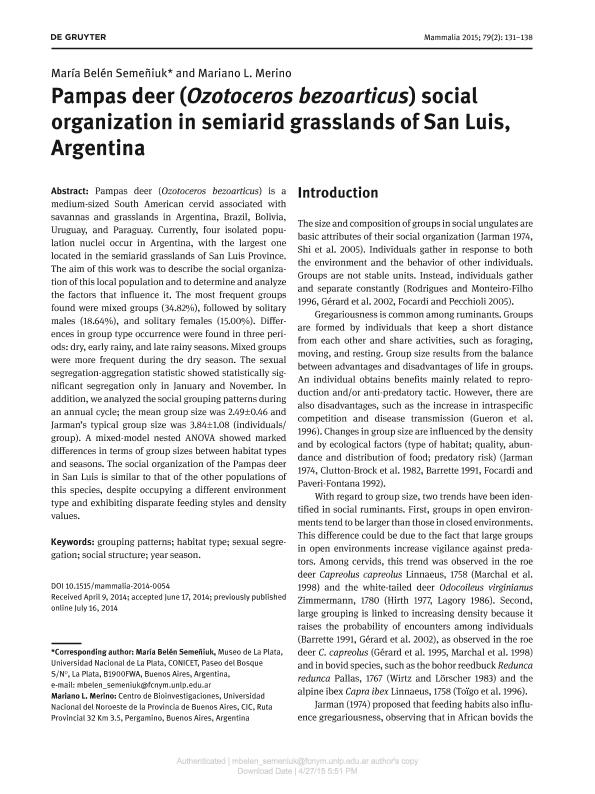Artículo
Pampas deer (Ozotoceros bezoarticus) social organization in semiarid grasslands of San Luis, Argentina
Fecha de publicación:
05/2015
Editorial:
De Gruyter
Revista:
Mammalia
ISSN:
0025-1461
e-ISSN:
1864-1547
Idioma:
Inglés
Tipo de recurso:
Artículo publicado
Clasificación temática:
Resumen
Pampas deer (Ozotoceros bezoarticus) is a medium-sized South American cervid associated with savannas and grasslands in Argentina, Brazil, Bolivia, Uruguay, and Paraguay. Currently, four isolated population nuclei occur in Argentina, with the largest one located in the semiarid grasslands of San Luis Province. The aim of this work was to describe the social organization of this local population and to determine and analyze the factors that influence it. The most frequent groups found were mixed groups (34.82%), followed by solitary males (18.64%), and solitary females (15.00%). Differences in group type occurrence were found in three periods: dry, early rainy, and late rainy seasons. Mixed groups were more frequent during the dry season. The sexual segregation-aggregation statistic showed statistically significant segregation only in January and November. In addition, we analyzed the social grouping patterns during an annual cycle; the mean group size was 2.49±0.46 and Jarman's typical group size was 3.84±1.08 (individuals/group). A mixed-model nested ANOVA showed marked differences in terms of group sizes between habitat types and seasons. The social organization of the Pampas deer in San Luis is similar to that of the other populations of this species, despite occupying a different environment type and exhibiting disparate feeding styles and density values.
Archivos asociados
Licencia
Identificadores
Colecciones
Articulos(CCT - LA PLATA)
Articulos de CTRO.CIENTIFICO TECNOL.CONICET - LA PLATA
Articulos de CTRO.CIENTIFICO TECNOL.CONICET - LA PLATA
Citación
Semeñiuk, María Belén; Merino, Mariano Lisandro; Pampas deer (Ozotoceros bezoarticus) social organization in semiarid grasslands of San Luis, Argentina; De Gruyter; Mammalia; 79; 2; 5-2015; 131-138
Compartir
Altmétricas




